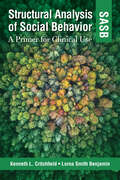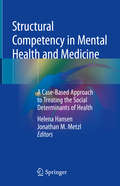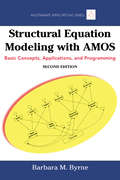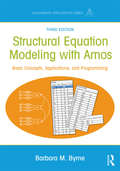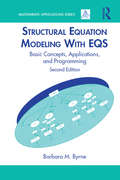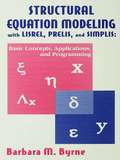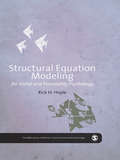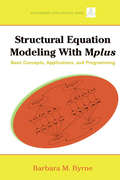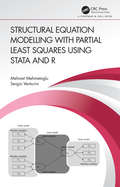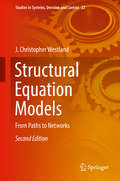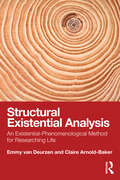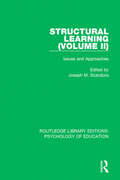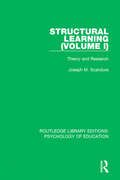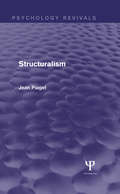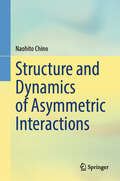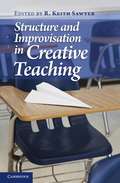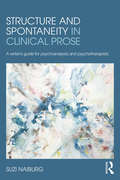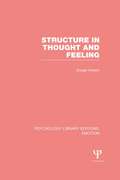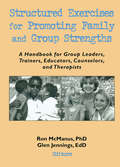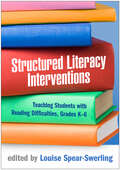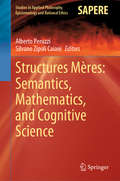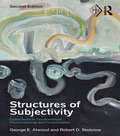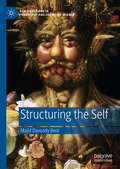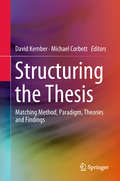- Table View
- List View
Structural Analysis of Social Behavior (SASB): A Primer for Clinical Use
by Kenneth L. Critchfield PhD Dr. Lorna Smith Benjamin PhDStructural Analysis of Social Behavior (SASB) helps clinicians and researchers make objective assessments of relationship patterns, and enables clients to improve their social interactions. SASB can help identify connections between clients' current symptoms, and their current and historical relationship patterns. The SASB coding system serves as the basis for case formulation, which in turn informs the choice of interventions used in a variety of therapeutic approaches. SASB can also be used to evaluate the effectiveness of interventions, thus keeping therapy on track. This book summarizes over 50 years of research and clinical practice with SASB, and demonstrates how it can be used with any therapeutic approach. It has been traditionally used with patients who are comorbid, often rehospitalized, dysfunctional, and suicidal, although it can be used with any clinical population. SASB offers providers a therapy compass that helps clarify where the client is now, and pointing in the direction they need to go in order to reach their therapy goals.
Structural Competency in Mental Health and Medicine: A Case-Based Approach to Treating the Social Determinants of Health
by Jonathan M. Metzl Helena HansenThis book documents the ways that clinical practitioners and trainees have used the “structural competency” framework to reduce inequalities in health. The essays describe on-the-ground ways that clinicians, educators, and activists craft structural interventions to enhance health outcomes, student learning, and community organizing around issues of social justice in health and healthcare. Each chapter of the book begins with a case study that illuminates a competency in reorienting clinical and public health practice toward community, institutional and policy level intervention based on alliances with social agencies, community organizations and policy makers. Written by authors who are trained in both clinical and social sciences, the chapters cover pedagogy in classrooms and clinics, community collaboration, innovative health promotion approaches in non-health sectors and in public policies, offering a view of effective care as structural intervention and a road map toward its implementation. Structural Competency in Mental Health and Medicine is a cutting-edge resource for psychiatrists, primary care physicians, addiction medicine specialists, emergency medicine specialists, nurses, social workers, public health practitioners, and other clinicians working toward equality in health.
Structural Equation Modeling With AMOS: Basic Concepts, Applications, and Programming, Second Edition
by Barbara M. ByrneThis bestselling text provides a practical guide to the basic concepts of structural equation modeling (SEM) and the AMOS program (Versions 17 & 18). The author reviews SEM applications based on actual data taken from her research. Noted for its non-mathematical language, this book is written for the novice SEM user. With each chapter, the author "walks" the reader through all steps involved in testing the SEM model including: an explanation of the issues addressed an illustration of the hypothesized and posthoc models tested AMOS input and output with accompanying interpretation and explanation The function of the AMOS toolbar icons and their related pull-down menus The data and published reference upon which the model was based. With over 50% new material, highlights of the new edition include: All new screen shots featuring Version 17 of the AMOS program All data files now available at www.routledge.com/9780805863734 Application of a multitrait-mulitimethod model, latent growth curve model, and second-order model based on categorical data All applications based on the most commonly used graphical interface The automated multi-group approach to testing for equivalence The book opens with an introduction to the fundamental concepts of SEM and the basics of the AMOS program. The next 3 sections present applications that focus on single-group, multiple-group, and multitrait-mutimethod and latent growth curve models. The book concludes with a discussion about non-normal and missing (incomplete) data and two applications capable of addressing these issues. Intended for researchers, practitioners, and students who use SEM and AMOS in their work, this book is an ideal resource for graduate level courses on SEM taught in departments of psychology, education, business, and other social and health sciences and/or as a supplement in courses on applied statistics, multivariate statistics, statistics II, intermediate or advanced statistics, and/or research design. Appropriate for those with limited or no previous exposure to SEM, a prerequisite of basic statistics through regression analysis is recommended.
Structural Equation Modeling With AMOS: Basic Concepts, Applications, and Programming, Third Edition (Multivariate Applications Series)
by Barbara M. ByrneThis bestselling text provides a practical guide to structural equation modeling (SEM) using the Amos Graphical approach. Using clear, everyday language, the text is ideal for those with little to no exposure to either SEM or Amos. The author reviews SEM applications based on actual data taken from her own research. Each chapter "walks" readers through the steps involved (specification, estimation, evaluation, and post hoc modification) in testing a variety of SEM models. Accompanying each application is: an explanation of the issues addressed and a schematic presentation of hypothesized model structure; Amos? input and output with interpretations; use of the Amos toolbar icons and pull-down menus; and data upon which the model application was based, together with updated references pertinent to the SEM model? tested. Thoroughly updated throughout, the new edition features: All new screen shots featuring Amos Version 23.?? Descriptions and illustrations of Amos’ new Tables View format which enables the specification of a structural model in spreadsheet form.???? Key concepts and/or techniques that introduce each chapter. Alternative approaches to model analyses when enabled by Amos thereby allowing users to determine the method best suited to their data.? Provides analysis of the same model based on continuous and categorical data (Ch. 5) thereby enabling readers to observe two ways of specifying and testing the same model as well as compare results. All applications based on the Amos graphical mode interface accompanied by more "how to" coverage of graphical techniques unique to Amos. More explanation of key procedures and analyses that address questions posed by readers All application data files are available at www.routledge.com/9781138797031. The two introductory chapters in Section 1 review the fundamental concepts of SEM methodology and a general overview of the Amos program. Section 2 provides single-group analyses applications including two first-order confirmatory factor analytic (CFA) models, one second-order CFA model, and one full latent variable model. Section 3 presents multiple-group analyses applications with two rooted in the analysis of covariance structures and one in the analysis of mean and covariance structures. Two models that are increasingly popular with SEM practitioners, construct validity and testing change over time using the latent growth curve, are presented in Section 4. The book concludes with a review of the use of bootstrapping to address non-normal data and a review of missing (or incomplete) data in Section 5. An ideal supplement for graduate level courses in psychology, education, business, and social and health sciences that cover the fundamentals of SEM with a focus on Amos, this practical text continues to be a favorite of both researchers and practitioners. A prerequisite of basic statistics through regression analysis is recommended but no exposure to either SEM or Amos is required.
Structural Equation Modeling With EQS: Basic Concepts, Applications, and Programming, Second Edition (Multivariate Applications Series)
by Barbara M. ByrneReaders who want a less mathematical alternative to the EQS manual will find exactly what they're looking for in this practical text. Written specifically for those with little to no knowledge of structural equation modeling (SEM) or EQS, the author's goal is to provide a non-mathematical introduction to the basic concepts of SEM by applying these principles to EQS, Version 6.1. The book clearly demonstrates a wide variety of SEM/EQS applications that include confirmatory factor analytic and full latent variable models. Written in a "user-friendly" style, the author "walks" the reader through the varied steps involved in the process of testing SEM models: model specification and estimation, assessment of model fit, EQS output, and interpretation of findings. Each of the book's applications is accompanied by: a statement of the hypothesis being tested, a schematic representation of the model, explanations of the EQS input and output files, tips on how to use the pull-down menus, and the data file upon which the application is based. The book carefully works through applications starting with relatively simple single group analyses, through to more advanced applications, such as a multi-group, latent growth curve, and multilevel modeling. The new edition features: many new applications that include a latent growth curve model, a multilevel model, a second-order model based on categorical data, a missing data multigroup model based on the EM algorithm, and the testing for latent mean differences related to a higher-order model; a CD enclosed with the book that includes all application data; vignettes illustrating procedural and/or data management tasks; and description of how to build models both interactively using the BUILD-EQ interface and graphically using the EQS Diagrammer.
Structural Equation Modeling With Lisrel, Prelis, and Simplis: Basic Concepts, Applications, and Programming (Multivariate Applications Series)
by Barbara M. ByrneThis book illustrates the ease with which various features of LISREL 8 and PRELIS 2 can be implemented in addressing research questions that lend themselves to SEM. Its purpose is threefold: (a) to present a nonmathmatical introduction to basic concepts associated with SEM, (b) to demonstrate basic applications of SEM using both the DOS and Windows versions of LISREL 8, as well as both the LISREL and SIMPLIS lexicons, and (c) to highlight particular features of the LISREL 8 and PRELIS 2 progams that address important caveats related to SEM analyses. This book is intended neither as a text on the topic of SEM, nor as a comprehensive review of the many statistical funcitons available in the LISREL 8 and PRELIS 2 programs. Rather, the intent is to provide a practical guide to SEM using the LISREL approach. As such, the reader is "walked through" a diversity of SEM applications that include both factor analytic and full latent variable models, as well as a variety of data management procedures.
Structural Equation Modeling for Social and Personality Psychology (The SAGE Library of Methods in Social and Personality Psychology)
by Rick K HoyleStructural Equation Modeling offers a nontechnical presentation of SEM with an emphasis on applications in social and personality psychology. The presentation begins with a discussion of the relation between SEM and statistical strategies widely used in social and personality psychology such as analysis of variance, multiple regression analysis, and factor analysis. This introduction is followed by a nontechnical presentation of the terminology, notation, and steps followed in a typical application of SEM. The reminder of the volume offers a practically-oriented presentation of specific applications using examples typical of social and personality psychology and offering advice for dealing with relevant issues such as missing data, choice of software, and best practices for interpreting and reporting results. The SAGE Library in Social and Personality Psychology Methods provides students and researchers with an understanding of the methods and techniques essential to conducting cutting-edge research. Each volume within the Library explains a specific topic and has been written by an active scholar (or scholars) with expertise in that particular methodological domain. Assuming no prior knowledge of the topic, the volumes are clear and accessible for all readers. In each volume, a topic is introduced, applications are discussed, and readers are led step by step through worked examples. In addition, advice about how to interpret and prepare results for publication are presented.
Structural Equation Modeling with Mplus: Basic Concepts, Applications, and Programming (Multivariate Applications Series)
by Barbara M. ByrneModeled after Barbara Byrne’s other best-selling structural equation modeling (SEM) books, this practical guide reviews the basic concepts and applications of SEM using Mplus Versions 5 & 6. The author reviews SEM applications based on actual data taken from her own research. Using non-mathematical language, it is written for the novice SEM user. With each application chapter, the author "walks" the reader through all steps involved in testing the SEM model including: an explanation of the issues addressed illustrated and annotated testing of the hypothesized and post hoc models explanation and interpretation of all Mplus input and output files important caveats pertinent to the SEM application under study a description of the data and reference upon which the model was based the corresponding data and syntax files available at http://www.psypress.com/sem-with-mplus/datasets . The first two chapters introduce the fundamental concepts of SEM and important basics of the Mplus program. The remaining chapters focus on SEM applications and include a variety of SEM models presented within the context of three sections: Single-group analyses, Multiple-group analyses, and other important topics, the latter of which includes the multitrait-multimethod, latent growth curve, and multilevel models. Intended for researchers, practitioners, and students who use SEM and Mplus, this book is an ideal resource for graduate level courses on SEM taught in psychology, education, business, and other social and health sciences and/or as a supplement for courses on applied statistics, multivariate statistics, intermediate or advanced statistics, and/or research design. Appropriate for those with limited exposure to SEM or Mplus, a prerequisite of basic statistics through regression analysis is recommended.
Structural Equation Modelling with Partial Least Squares Using Stata and R
by Mehmet Mehmetoglu Sergio VenturiniPartial least squares structural equation modelling (PLS-SEM) is becoming a popular statistical framework in many fields and disciplines of the social sciences. The main reason for this popularity is that PLS-SEM can be used to estimate models including latent variables, observed variables, or a combination of these. The popularity of PLS-SEM is predicted to increase even more as a result of the development of new and more robust estimation approaches, such as consistent PLS-SEM. The traditional and modern estimation methods for PLS-SEM are now readily facilitated by both open-source and commercial software packages. This book presents PLS-SEM as a useful practical statistical toolbox that can be used for estimating many different types of research models. In so doing, the authors provide the necessary technical prerequisites and theoretical treatment of various aspects of PLS-SEM prior to practical applications. What makes the book unique is the fact that it thoroughly explains and extensively uses comprehensive Stata (plssem) and R (cSEM and plspm) packages for carrying out PLS-SEM analysis. The book aims to help the reader understand the mechanics behind PLS-SEM as well as performing it for publication purposes. Features: Intuitive and technical explanations of PLS-SEM methods Complete explanations of Stata and R packages Lots of example applications of the methodology Detailed interpretation of software output Reporting of a PLS-SEM study Github repository for supplementary book material The book is primarily aimed at researchers and graduate students from statistics, social science, psychology, and other disciplines. Technical details have been moved from the main body of the text into appendices, but it would be useful if the reader has a solid background in linear regression analysis.
Structural Equation Models: From Paths to Networks (Studies in Systems, Decision and Control #22)
by J. Christopher WestlandThis new edition surveys the full range of available structural equation modeling (SEM) methodologies. The book has been updated throughout to reflect the arrival of new software packages, which have made analysis much easier than in the past. Applications in a broad range of disciplines are discussed, particularly in the social sciences where many key concepts are not directly observable. This book presents SEM’s development in its proper historical context–essential to understanding the application, strengths and weaknesses of each particular method. This book also surveys the emerging path and network approaches that complement and enhance SEM, and that are growing in importance. SEM’s ability to accommodate unobservable theory constructs through latent variables is of significant importance to social scientists. Latent variable theory and application are comprehensively explained and methods are presented for extending their power, including guidelines for data preparation, sample size calculation and the special treatment of Likert scale data. Tables of software, methodologies and fit statistics provide a concise reference for any research program, helping assure that its conclusions are defensible and publishable.
Structural Existential Analysis: An Existential-Phenomenological Method for Researching Life
by Emmy van Deurzen Claire Arnold-BakerStructural Existential Analysis (SEA) is a qualitative research method which uses an existential-phenomenological framework that has been developed through decades of therapeutic and research practice. This book describes the method of SEA and how to apply it to qualitative research.The book starts with a detailed description of the existential underpinnings of SEA, drawing on a range of phenomenologists, to demonstrate the need for a phenomenology of interiority. The method is described in full, explaining the use of a specific form of self-reflection (SOAR) and of the Existential Research Dialogue. The second part focuses on the analysis of the research data. A full description is given of each of the filters, in terms of their origin, their meaning and of the specific ways in which they are applied. The text is enlivened by ample examples demonstrating how the filters can be used and how the analysis can draw out different aspects of human experience throughout the process.The book will be essential reading, for all those involved in education, training or research in existential therapies, clinical psychology and counselling psychology.
Structural Information Theory
by Emanuel Leeuwenberg Peter A. van der HelmStructural information theory is a coherent theory about the way the human visual system organises a raw visual stimulus into objects and object parts. To humans, a visual stimulus usually has one clear interpretation even though, in theory, any stimulus can be interpreted in numerous ways. To explain this, the theory focuses on the nature of perceptual interpretations rather than on underlying process mechanisms and adopts the simplicity principle which promotes efficiency of internal resources rather than the likelihood principle which promotes veridicality in the external world. This theoretically underpinned starting point gives rise to quantitative models and verifiable predictions for many visual phenomena, including amodal completion, subjective contours, transparency, brightness contrast, brightness assimilation and neon illusions. It also explains phenomena such as induced temporal order, temporal context effects and hierarchical dominance effects, and extends to evaluative pattern qualities such as distinctiveness, interestingness and beauty.
Structural Learning: Issues and Approaches (Routledge Library Editions: Psychology of Education)
by Joseph M. ScanduraOriginally published in 1976, this title is an edited volume and reflects the major approaches being taken in structural learning at the time. Chapter 1 deals with the basic question of whether competence (knowledge) should be characterized in terms of rules (automata), on the one hand, or associations on the other. The bulk of Chapter 2 is devoted to a series of earlier experiments on rule learning by the editor and his associates. The two contributions in Chapter 3 deal with graph theoretical models. Piagetian models constitute the subject of Chapter 4. Chapter 5 deals with attempts to stimulate human behaviour with a computer. Chapter 6 ranges over a wide variety of competence models, with particular reference to logic and mathematics. In Chapter 7 the editor proposes a new theory of structural learning, together with some empirical results.
Structural Learning: Theory and Research (Routledge Library Editions: Psychology of Education)
by Joseph M. ScanduraOriginally published in 1973, this book was published in two volumes. In the first volume, the author describes what he sees as the rudiments of three deterministic partial theories of structural learning. The first involves competence, partial theories which deal only with the problem of how to account for the various kinds of behavior of which people are typically capable. Special attention is given to mathematical competence. Nothing is said about learning or performance. The second partial theory is concerned with motivation, learning, and performance under idealized conditions, and is obtained from the first partial theory by imposing further structure on it. This theory says nothing about memory of the limited capacity of human subjects to process information. … The final theory is obtained from the second by making additional assumptions, which bring memory and finite information processing into the picture. The theory is still partial, however, since no attempt is made to deal with certain ultra-short-term behavioral phenomena which appear to depend directly on particular physiological characteristics.
Structuralism (Psychology Revivals)
by Jean PiagetOriginally published in English in 1971, structuralism was an increasingly important method of analysis in disciplines as diverse as mathematics, physics, biology, psychology, linguistics, sociology, anthropology and philosophy. Piaget here offers both a definitive introduction to the method and a brilliant critique of the principal structuralist positions. He explains and evaluates the work of the main people at work in the field – Claude Lévi-Strauss, Michel Foucault, Talcott Parsons, Noam Chomsky – and concludes that structuralism has a rich and fruitful future ahead of it. An indispensable work for serious students and working scholars in almost every field, the book is also an important addition to Piaget’s life-long study of the relationship of language and thought.
Structure and Dynamics of Asymmetric Interactions
by Naohito ChinoThis book integrates the fundamentals of asymmetric multidimensional scaling, spectral graph theory, graph embedding theory, and various dynamical systems theories, that deal with the static and dynamic aspects of asymmetric phenomena. In this way, it provides a comprehensive introduction to theories and methods for analyzing phenomena observed universally in social, behavioral, economical, geographical, biological, neural, chemical reaction and other networks. The topics addressed in here include the notions of asymmetric similarity matrices, graph spectra, dimension reduction, and difference and differential equations to describe the dynamics of networks, bifurcation of vector fields, Mandelbrot sets, fractals and chaos, and Hilbert spaces. Illustrated by carefully chosen examples and supported by extensive simulation studies, the book is highly recommended to readers who seek to discover static asymmetric structures among members or nodes. It also appeals to those who want to understand the kinds of dynamics that are theoretically possible in their research domains.
Structure and Improvisation in Creative Teaching
by R. Keith Sawyer"With an increasing emphasis on creativity and innovation in the twenty-first century, teachers need to be creative professionals just as students must learn to be creative. And yet, schools are institutions with many important structures and guidelines that teachers must follow. Effective creative teaching strikes a delicate balance between structure and improvisation. The authors draw on studies of jazz, theater improvisation, and dance improvisation to demonstrate that the most creative performers work within similar structures and guidelines. By looking to these creative genres, the book provides practical advice for teachers who wish to become more creative professionals"--
Structure and Spontaneity in Clinical Prose: A writer's guide for psychoanalysts and psychotherapists
by Suzi NaiburgStructure and Spontaneity in Clinical Prose will teach you to read gifted writers for inspiration and practical lessons in the craft of writing; apply the principles and techniques of the paradigmatic, narrative, lyric narrative, evocative, and enactive modes of clinical prose; and put what you learn immediately into practice in eighty-four writing exercises. Each of the five modes uses different means to construct worlds out of language. The paradigmatic abstracts ideas from experience to build concepts and theories. The narrative mode organizes experience through time, creating meaningful relationships between causes and effects. Lyric narratives present events unfolding in an uncertain present. The evocative mode works by invitation and suggestion, and the enactive mode creates an experience to be lived as well as thought. Structure and Spontaneity is fundamentally a book about reading and writing in new and different ways. It is an invaluable resource for new and experienced psychoanalysts and psychotherapists and for students, teachers, editors, and writers in the humanities and social sciences.
Structure in Thought and Feeling (Psychology Library Editions: Emotion)
by Susan AylwinHow does a person’s way of thinking influence their personality, their values and their choice of career? In this important study, originally published in 1985, Susan Aylwin uses such questions as a starting point for elucidating the relationship between thought and feeling. Three modes of thought are compared in detail: inner speech, visual imagery and enactive imagery – the last being an important addition to our understanding of mental representations. The structural characteristics of all three types are analysed using an association technique. Their affective aspects are then explored through a variety of means, including the analysis of daydreams, an examination of the evaluative complements of categorizing, the study of cognitive style, an exploration of such social feelings as embarrassment, and the experiential study of strong emotion. The author ends by integrating her findings, showing how thought and feeling are related aspects of the temporal organization of consciousness. Structure in Thought and Feeling is written in a lively and accessible style, and brings a refreshing perspective to many issues of central concern to psychologists interested in cognition, emotion, personality and psychotherapy.
Structured Exercises for Promoting Family and Group Strengths: A Handbook for Group Leaders, Trainers, Educators, Counselors, and Therapists
by Terry S Trepper Glen H Jennings Ronnie McmanusThis handbook for professionals presents an array of techniques for teaching and reinforcing social skills for successful relationships. It contains over 70 new structured exercises that can be used to help individuals, dyads, families, and groups become happier in their relationships. The exercises come complete with step-by-step instructions for easy use. Structured Exercises for Promoting Family and Group Strengths is a goldmine of resources for group leaders and counselors. You can use it in planning and conducting workshops and retreats or for working with individuals or families in counseling. The book saves you time and energy as each exercise is accompanied by suggestions for procedures, variations, and trainer's notes. The exercises, which have all been field tested with a variety of audiences, are grouped into six broad categories:Icebreakers introduce people to the subject of group dynamics and to each other in a workshop setting.Assessors help people assess relationships and gain insight for constructive change.Dyad/couple discussion starters facilitate communication and open dialogue for dyads who find themselves in dysfunctional situations.Group/family discussion starters strengthen communication within groups or families and increase understanding of how the group functions.Enhancers aid in the development of positive regard of self and others.Energizers perk up the group or family when fatigue occurs.The exercises provide an experiential approach to learning in which each participant is actively and creatively involved. Readers will find that these relationship-enhancing exercises offer a catalyst for dramatic change in the lives of individuals, dyads, families, and groups. Structured Exercises for Promoting Family and Group Strengths is a valuable sourcebook of ideas for use by persons in the helping professions, including counselors, psychologists, marriage and family therapists, social workers, chaplains, corrections officers, and educators.<
Structured Literacy Interventions: Teaching Students with Reading Difficulties, Grades K-6 (The Guilford Series on Intensive Instruction)
by Louise Spear-SwerlingComprehensive and evidence-based, Structured Literacy (SL) approaches place a high value on explicit, systematic, and sequential instruction. This book brings together leading experts to present a wealth of SL interventions for different components of literacy. Chapters describe instructional strategies for supporting phonological awareness, basic and multisyllabic word decoding, spelling, reading fluency, vocabulary, oral and reading comprehension, and written expression, especially for at-risk readers and those with disabilities. Including case studies, sample intervention activities, lesson plans, and end-of-chapter application activities, the book contains reproducible tools that can be downloaded and printed in a convenient 8½&“ x 11&” size. An NCTQ Exemplary Text for Reading Instruction See also Louise Spear-Swerling's authored volume, The Structured Literacy Planner: Designing Interventions for Common Reading Difficulties, Grades 1–9, which provides blueprints for tailoring interventions based on a learner's reading profile.
Structures Mères: Semantics, Mathematics, and Cognitive Science (Studies in Applied Philosophy, Epistemology and Rational Ethics #57)
by Alberto Peruzzi Silvano Zipoli CaianiThis book reports on cutting-edge concepts related to Bourbaki’s notion of structures mères. It merges perspectives from logic, philosophy, linguistics and cognitive science, suggesting how they can be combined with Bourbaki’s mathematical structuralism in order to solve foundational, ontological and epistemological problems using a novel category-theoretic approach. By offering a comprehensive account of Bourbaki’s structuralism and answers to several important questions that have arisen in connection with it, the book provides readers with a unique source of information and inspiration for future research on this topic.
Structures of Subjectivity: Explorations in Psychoanalytic Phenomenology and Contextualism (Psychoanalytic Inquiry Book Series #4)
by Robert D. Stolorow George E. AtwoodStructures of Subjectivity: Explorations in Psychoanalytic Phenomenology and Contextualism, is a revised and expanded second edition of a work first published in 1984, which was the first systematic presentation of the intersubjective viewpoint – what George Atwood and Robert Stolorow called psychoanalytic phenomenology – in psychoanalysis. This edition contains new chapters tracing the further development of their thinking over the ensuing decades and explores the personal origins of their most essential ideas. In this new edition, Atwood and Stolorow cover the philosophical and theoretical assumptions of psychoanalysis and present a broad approach that they have designated phenomenological contextualism. This approach addresses personal subjective worlds in all their richness and idiosyncrasy and focuses on their relational contexts of origin and therapeutic transformation. Structures of Subjectivity covers the principles guiding the practice of psychoanalytic therapy from the authors' viewpoints and includes numerous detailed clinical case studies. The book will be essential reading for psychoanalysts, practitioners of psychotherapy, psychiatrists, psychologists, counselors, and social workers. It will also be of interest to scholars and students with an interest in psychoanalytic theory and practice, and its philosophical premises.
Structuring the Self (New Directions in Philosophy and Cognitive Science)
by Majid Davoody BeniThis book presents a unified account of the self, based on a network of knowledge sourced from several scientific accounts of selfhood. Beni constructs his ontological account of the self from the common structure that underpins the theoretical diversity that is manifested in rival and sometimes incompatible scientific accounts of the self and its aspects. The enterprise is inspired by recent structural realist theories in the philosophy of science, specifying the basic structure of the self, and explaining how representational, phenomenal, and social aspects of the self are embodied within this structure.
Structuring the Thesis: Matching Method, Paradigm, Theories and Findings
by Michael Corbett David KemberThe book is a collective investigation of the structuring of theses in education, the social sciences and other disciplines that commonly do not follow the standard procedures of the scientific method. To help research students design a structure for their own thesis and liberate their investigations from the constraints associated with the use of the conventional structure, it explains how the structures adopted were designed to suit the topic, methodology and paradigm. It also provides a wide range of examples to draw upon, which suit a broad spectrum of theory, methodological approaches, research methods and paradigms. Additionally, by analyzing the methodologies and paradigms, and reviewing the methodological and paradigmatic spectrum, it offers a significant contribution to the way research is conceptualized.The book addresses a number of key questions faced by students, supervisors and examiners: •Why do examiners often find it difficult to read work in non-scientific disciplines when theses are structured in accordance with the conventional scientific method?•Why do students in non-scientific disciplines struggle to write up the outcomes of their research in the conventional structure?•What alternative thesis structures can be devised to better suit the wide range of methods?•Which theories and paradigms are commonly followed in education and the social sciences and how do these perspectives influence the research process? •What methods, theories and paradigms are commonly adopted by education and social science students and what problems do these pose when students write their theses?
